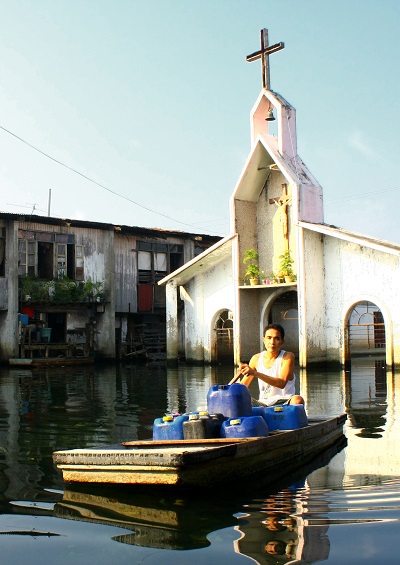Adapt to Survive: Urban Flooding in the Philippines
Unable to afford relocation, residents of the flooded village of Artex are forced to adapt to survive.
November 14, 2015

Gregorio B. Dantes, Jr., is a freelance photojournalist for news agencies, a visual artist and a freelance photography lecturer. A person with a disability, he has paralysis in his left hand as a result of polio.
At the heart of Malabon, a low-lying district next to Manila Bay, stands Artex village, a one-hectare compound of two-story houses. Once owned by one of the Philippines’ largest textile companies, it has been permanently flooded for nearly a decade.
Artex Yupangco Textile Mills Corporation built the compound in the late 1970s to house the work force of an adjacent textile plant. But within a few years, both the factory and the compound started running into trouble.
A series of labor disputes left relations between workers and management in poor shape, while at the same time, drainage of water was becoming more and more of a problem.
When it was built, the compound was surrounded by fishponds through which water would naturally drain into the sea. But one after another, the ponds were filled in and houses built on them. Road construction further blocked drainage channels.
Eventually, in 1989, after a severe strike and a major flood, the company surrendered and closed down. Overnight, the workers living in the 150 households in the compound found themselves without jobs but in possession of their homes.
At first, they were able to keep the water at bay using pumps, but eventually they too were defeated, and since 2004, the compound has been permanently flooded.
Normally, the water is around five feet deep, but after heavy rain it can double to 10 feet or more. Residents, mostly too poor to consider leaving, have long since adapted, buying or building boats to travel between homes, and even enjoying their status as a minor tourist attraction.
Text and photographs by Gregorio B. Dantes Jr.
Traveling by boat is the only way to move around the compound. With the water permanently five feet deep, residents are confined to the top floor of their two story homes.
Long used to living in a permanent flood, a lack of proper sanitation has become the biggest threat to the well-being of residents in the Artex compound. A study by the Department of Environmental Engineering at the University of the Philippines found high levels of bacteria attributable to human and animal fecal matter in the compound’s water.
 Gregorio B Dantes Jr is a freelance photojournalist for news agencies, a visual artist and a freelance photography lecturer. A person with a disability, he has paralysis in his left hand as a result of polio.
Gregorio B Dantes Jr is a freelance photojournalist for news agencies, a visual artist and a freelance photography lecturer. A person with a disability, he has paralysis in his left hand as a result of polio.The Other Hundred is a unique photo-book project (order here) aimed as a counterpoint to the Forbes 100 and other media rich lists by telling the stories of people around the world who are not rich but who deserve to be celebrated.
Its 100 photo-stories move beyond the stereotypes and cliches that fill so much of the world’s media to explore the lives of people whose aspirations and achievements are at least as noteworthy as any member of the world’s richest 1,000.
 Selected from 11,000 images shot in 158 countries and submitted by nearly 1,500 photographers, The Other Hundred celebrates those who will never find themselves on the world’s rich lists or celebrity websites.
Selected from 11,000 images shot in 158 countries and submitted by nearly 1,500 photographers, The Other Hundred celebrates those who will never find themselves on the world’s rich lists or celebrity websites.




